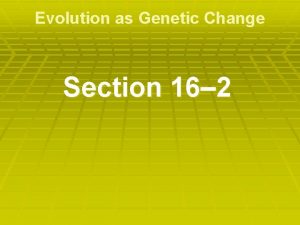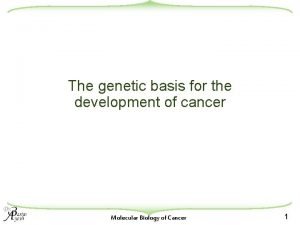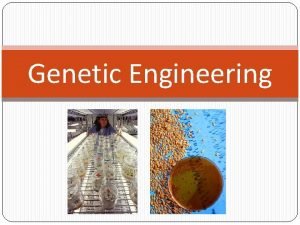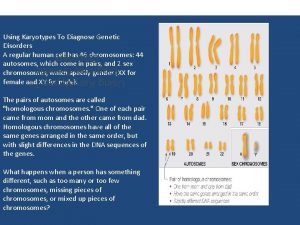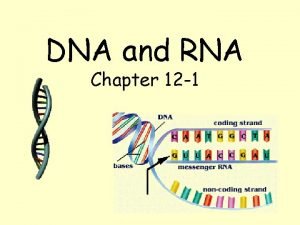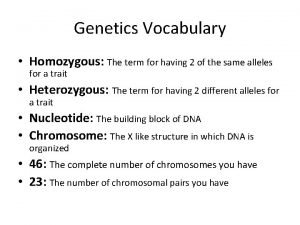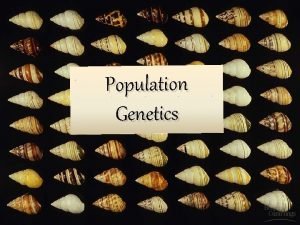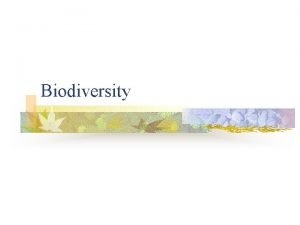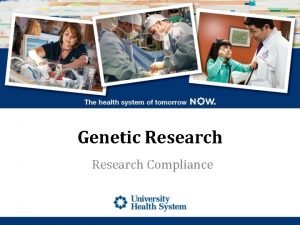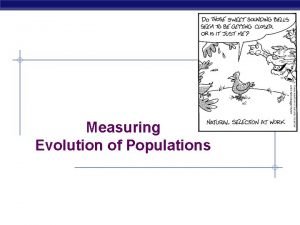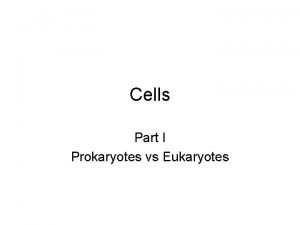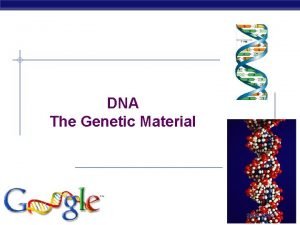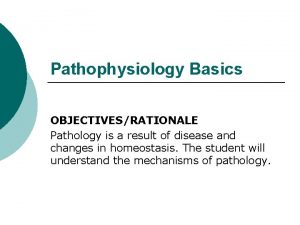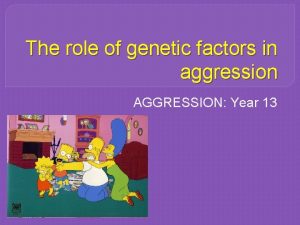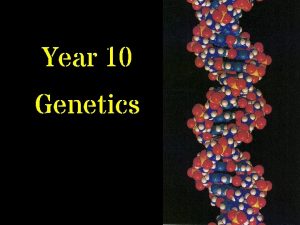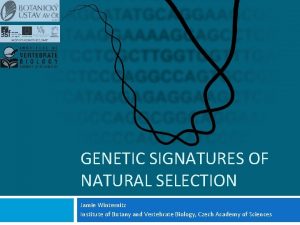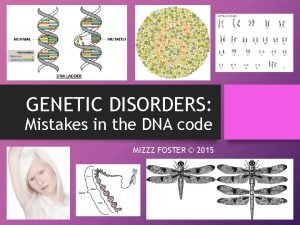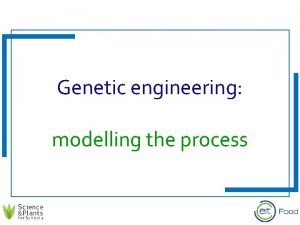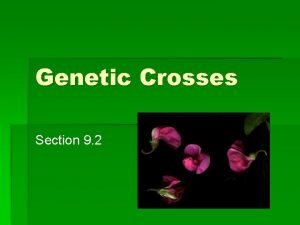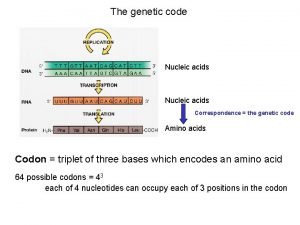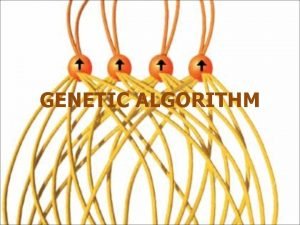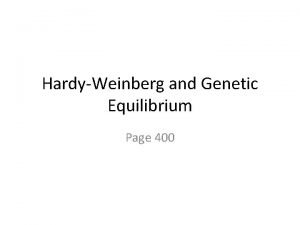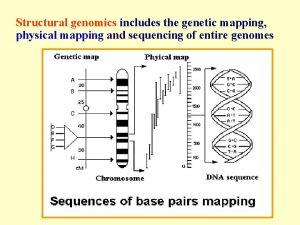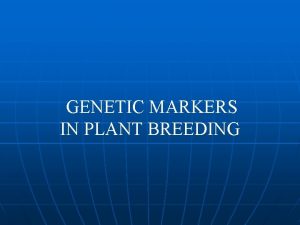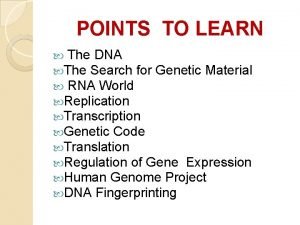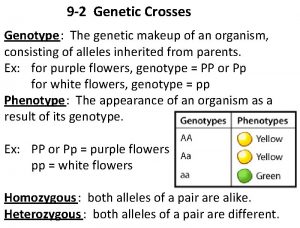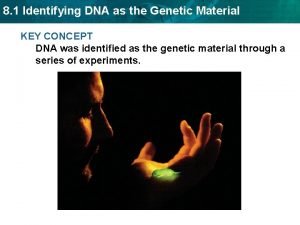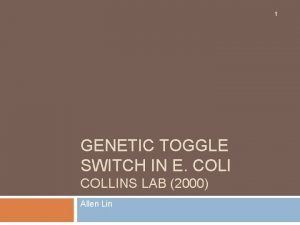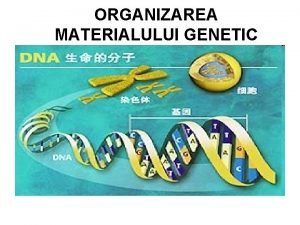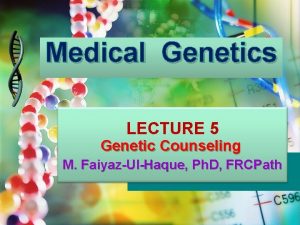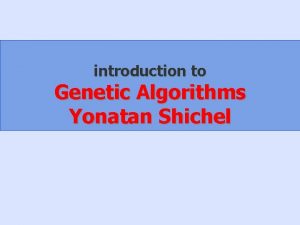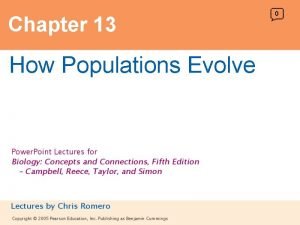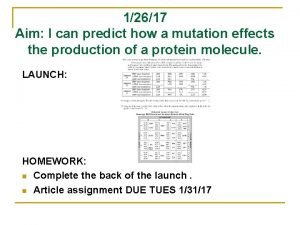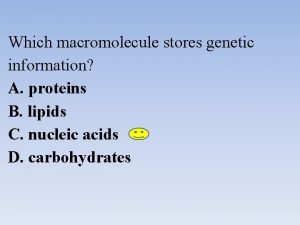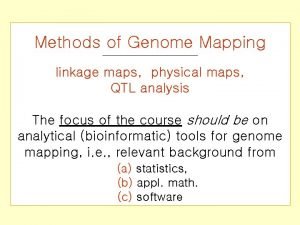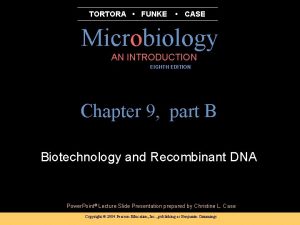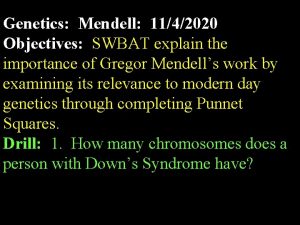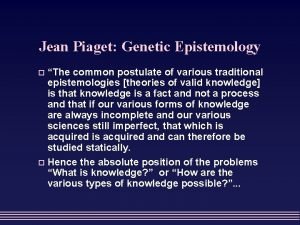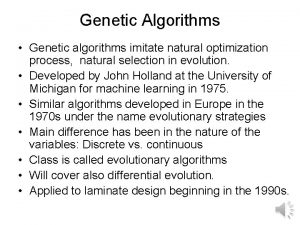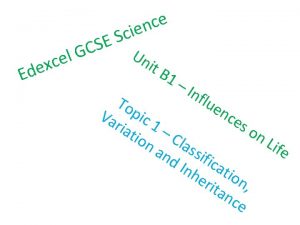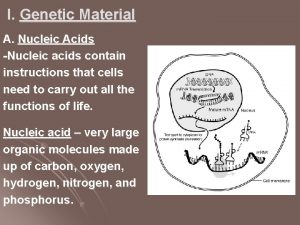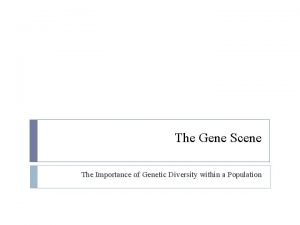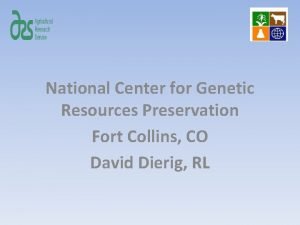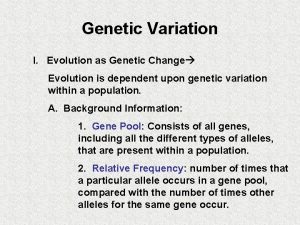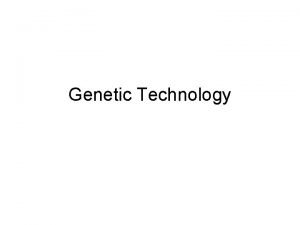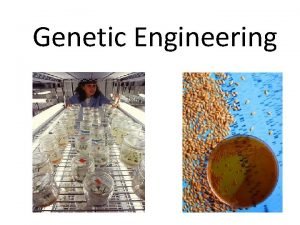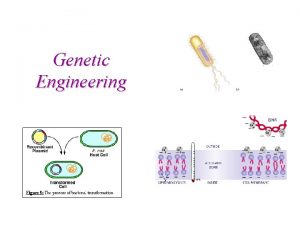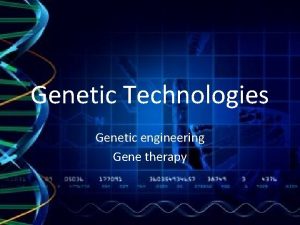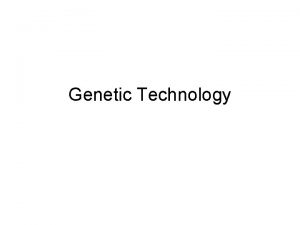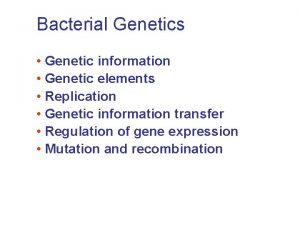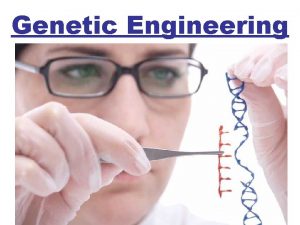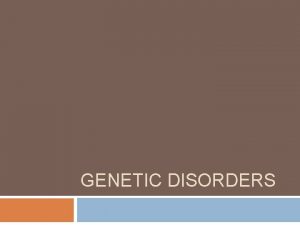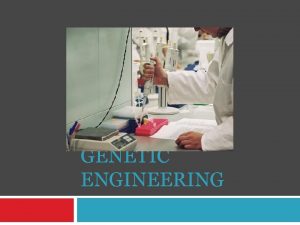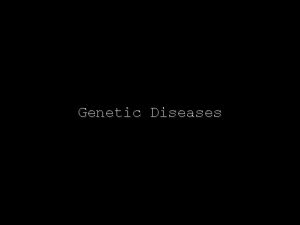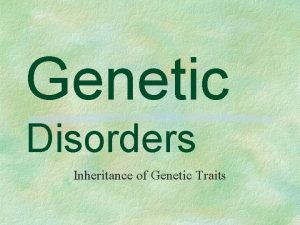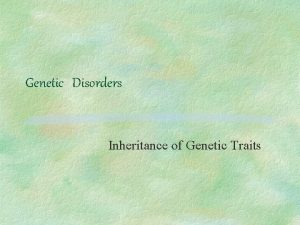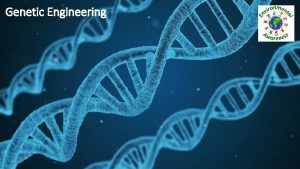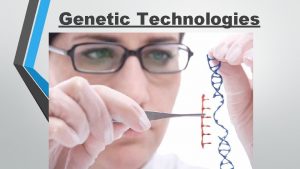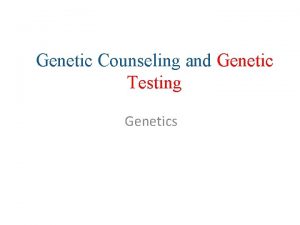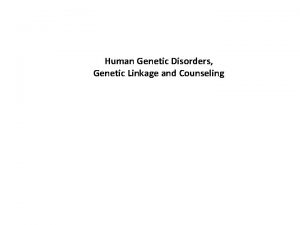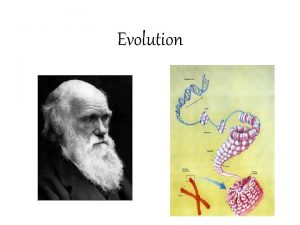Evolution in a Genetic Context EVOLUTION IS A




































































- Slides: 68


Evolution in a Genetic Context

EVOLUTION IS A PROCESS OF CHANGE OVER TIME

Microevolution involves the evolutionary changes within a population. • A population is defined as all the members of a single species occupying a particular area and reproducing with one another. • While variation within a population is important to evolution, it is not the only factor.

Evolution in a Genetic Context • Evolution at the population level can be studied using population genetics. • In population genetics, the various alleles at all the gene loci in all the individuals make up the gene pool of that population. • The gene pool of a population can be described in terms of gene frequencies.

The members of a population vary from one another. Variation is the raw material for evolutionary change.

What Causes Variations?

SOURCES OF VARIATIONS • • MUTATIONS CROSSING OVER INDEPENDENT ASSORTMENT RANDOM FERTILIZATION

• GENETIC VARIATION CAN BE DETERMINED

• EVOLUTION IS THE CHANGE OF GENE FREQUENCY WITHIN A POPULATION

HARDY-WEINBERG LAW • This law states an equilibrium of allele frequencies in a gene pool remains in effect in each succeeding generation of a sexually reproducing population if five conditions are met. http: //www. mhhe. com/biosci/esp/2001_gbio/folder_structure/ev/m 2/s 4/assets/real/evm 2 s 4_2. rm

Evolution in a Genetic Context (cont. ) • Hardy-Weinberg equilibrium is expressed as a simple binomial equation. p 2 + 2 pq + q 2 • The letters p and q are used to represent the frequency of the two alleles in the population.

Evolution in a Genetic Context (cont. ) http: //www. mhhe. com/biosci/esp/2001_gbio/folder_structure/ev/m 2/s 4/assets/real/evm 2 s 4_2. rm

Evolution in a Genetic Context (cont. )

Evolution in a Genetic Context (cont. ) • Hardy-Weinberg equilibrium is maintained in a population of sexual reproducing individuals if five conditions are met. – No net change in frequency due to mutations – No gene flow (migration of alleles in or out of the population) – Random mating must occur – No genetic drift – No natural selection

Evolution in a Genetic Context (cont. ) • These conditions are rarely if ever met in the real world. • Thus allele frequencies continually change and microevolution occurs. • The value of the Hardy-Weinberg principle is that it describes the factors that cause evolution.

Evolution in a Genetic Context (cont. ) • In order for natural selection to act on allele frequencies, the change must affect the phenotype associated with the gene. • A classic example of microevolution is industrial melanism.

Evolution in a Genetic Context (cont. )

Evolution in a Genetic Context (cont. )

Causes of Microevolution • Deviations from the conditions of Hardy. Weinberg equilibrium cause the allelic changes associated with microevolution. – Mutations – Gene flow – Genetic drift – Nonrandom mating – Natural selection

1. Genetic Mutations • Mutations are the raw material of evolutionary change. (alteration in the DNA nucleotide sequence of an allele) • Mutation introduces new variation into a population. • Gene mutations provide new alleles, and therefore are the ultimate source of variation. • This variation is adaptive if it helps members of a population adjust to specific environmental conditions.

2. Gene Flow • Gene flow, or gene migration, occurs when breeding members of a population leave a population or new members enter. • Gene migration can introduce new alleles to populations. • However continual gene flow between populations decreases differences in allele frequencies, preventing speciation.

3. Genetic Drift • Chance events that cause the allele frequency to change is called genetic drift. • The effect of genetic drift becomes increasingly important as the size of the population decreases.

Genetic Drift (cont. )

Genetic Drift (cont. ) • An example of genetic drift is the bottleneck effect. • A bottleneck occurs when an event or a catastrophe drastically reduces the number of organisms in a population. • The variation in that population may also be reduced, changing the allele frequencies within the population.

Genetic Drift (cont. )

• Bottleneck effect is caused by a severe reduction in population size due to natural disaster, predation, or habitat reduction. • Bottleneck effect causes severe reduction in total genetic diversity of the original gene pool. • The cheetah bottleneck causes relative infertility because of the intense interbreeding when populations were reduced in earlier times.

Genetic Drift (cont. ) • The founder effect is another example of genetic drift. • The founder effect occurs when combinations of alleles occur at a higher frequency in a population that has been isolated from a larger population.

Genetic Drift (cont. ) Genetically inherited diseases like Ellis-van Creveld are more concentrated among the Amish because they marry within their own community, which prevents new genetic variation from entering the population.

Genetic Drift (cont. ) • This is due to founding individuals containing a fraction of total genetic diversity of original population. • Which particular alleles are carried by the founders is dictated by chance alone.

4. Nonrandom Mating • When males and females reproduce together strictly by chance it is called random mating. • Any behavioral activity that fosters the selection of specific mates is nonrandom mating. – Assortive mating occurs when organisms select mates with a similar phenotype. – Sexual selection favors traits that increase the likelihood of securing a mate.

5. Natural Selection • Natural selection is the process that adapts populations to the environment. • Operates to select certain fit phenotypes, which add more genes to successive generations

5. Natural selection • The differential reproductive success of different genotypes.

Requires: • Variation (members differ from one another) • Inheritance( differences between individuals are heritable genetic differences) • Differential adaptedness (affect how well an organism is adapted to its environment) • Differential reproduction ( better adapted individuals are more likely to reproduce)

15. 2 Natural Selection (cont. )

Types of Selection • The variation within a population creates different phenotypes for a given trait. • The distribution of those phenotypes typically forms a normal distribution. • The effect of the three types of natural selection have different effects on this normal distribution.

TYPES OF SELECTION • DIRECTIONAL SELECTION • STABILIZING SELECTION • DISRUPTIVE SELECTION

Directional Selection • When one extreme phenotype is favored by natural selection, the distribution of the phenotype shifts in that direction. • This type of selection is therefore called directional selection.

Directional Selection (cont. )

Examples –A shift of dark-colored peppered moths from lightcolored correlated with increasing pollution. –Increases in insecticideresistant mosquitoes and resistance of malaria agents to medications

Stabilizing Selection • Stabilizing selection occurs when the intermediate, or most common, phenotype is favored. • This type of selection tends to narrow the variation in the phenotype over time. • This is the most common type of selection because it is associated with the adaptation of an organism to the environment.

Stabilizing Selection (cont. )

Disruptive Selection • In disruptive selection, natural selection acts upon both extremes of the phenotype. • This creates a increasing division within the population which may ultimately lead to two different phenotypes. • Disruptive selection is the process that leads to speciation.

British snails Vary because a wide range causes natural selection to vary In forest areas, thrushes feed on snails with light bands. In low-vegetation areas, thrushes feed on snails with dark shells that lack dark bands

Disruptive Selection (cont. )

Disruptive Selection (cont. )

DIRECTIONAL DISRUPTIVE STABILIZING

Maintenance of Variations • The preservation of variation in a population is important because it provides a foundation on which natural selection can act. • Variation is preserved by a variety of processes. – – – Mutations and genetic recombination Gene flow Natural selection Polymorphisms (differences in form) Diploidy and the heterozygotes

Diploidy and the Heterozygote • Natural selection can only cause evolution if the different alleles produce different phenotypes. • Because many organisms are diploid, heterozygotes are carriers of recessive alleles, preserving them in the population. • This also creates another phenotype that may contribute to ratio of balanced polymorphisms.

Diploidy and the Heterozygote (cont. ) • Surprisingly, the recessive allele occurs at a higher than expected frequency in regions where malaria is present, such as in Africa. • This occurs because the heterozygote phenotype is favored under these conditions and homozygotes are selected against.

Macroevolution • Microevolution involves changes on the small scale at the level of gene pool alleles. • In contrast, macroevolution involves evolution at the large scale as species originate, adapt to their environment, and possibly become extinct.

Defining Species • Speciation is an evolutionary event that gives rise to new species. • The biological species concept provides one definition of a species. – A group of organisms that interbreed with each other and share the same gene pool. – A group of organisms that produce fertile offspring. • Each species is reproductively isolated from every other species.

• Speciation is the final result of changes in gene pool allele and genotypic frequencies. • For two species to separate, gene flow must not occur between them.

Reproductive Barriers • In order for species to be reproductively isolated, they must be separated by barriers which prevent gene flow. • Reproductive barriers are also called isolating mechanisms.

Reproductive Barriers (cont. )

Reproductive Barriers (cont. ) • Prezygotic isolating mechanisms prevent reproduction and make fertilization unlikely. • Habitat isolation occurs when organisms cannot reproduce because they are in different habitats. • Temporal isolation occurs if the reproductive cycles of organisms occurs at different times.

Reproductive Barriers (cont. ) • The unique courtship patterns displayed by organisms can create behavioral isolation. • Mechanical isolation occurs when the genitalia are structurally incompatible. • Genetic isolation occurs when the fertilization does not occur, even when sperm and egg are brought together.

Reproductive Barriers (cont. ) • Postzygotic isolating mechanisms prevent hybrid organisms from developing (zygote mortality) or reproducing (hybrid sterility). • In the case of F 2 fitness, even a hybrid organism develops and reproduces, but the offspring of the hybrid are sterile.

Reproductive Barriers (cont. )

Models of Speciation • There are different ways in which the process of speciation can occur. • In allopatric speciation, an ancestral population is geographically isolated, resulting in the evolution of separate species.

Allopatric speciation Populations begin to diverge when gene flow between them is restricted and variations accumulate until the populations are reproductively isolated. http: //www. mhhe. com/biosci/esp/2001_gbio/default. htm

Allopatric speciation occurs when new species result from populations being separated by a geographical barrier that prevents their members from reproducing with each other.

Models of Speciation (cont. )

Models of Speciation (cont. ) • Sympatric speciation involves speciation without a geographic barrier. • One example of sympatric speciation is polyploidy, found more often in plants. • Polyploidy occurs when the number of chromosome sets increase to 3 n or more.

Models of Speciation (cont. )

Adaptive Radiation • Adaptive radiation involves the evolution of several new species from an ancestral species. • Adaptive radiation occurs as natural selection drives members of the ancestral species to adapt to several different environments.

Adaptive Radiation (cont. )

Natural Selection – Five Key Components: 1. There is genetic variation in populations. 2. Some of these are considered Adaptations (they act to increase the chances of survival) 3. More offspring are produced each generation than can possibly survive 4. Population limiting factors – competition, predation, disease etc 4. Those that survive reproduce and may pass their adaptations that happened help them survive on to offspring. 5. Over time, small changes accumulate leading to changes in population characteristics that are noticeable.
 Founder population
Founder population Genetic drift vs genetic flow
Genetic drift vs genetic flow Genetic programming vs genetic algorithm
Genetic programming vs genetic algorithm Genetic programming vs genetic algorithm
Genetic programming vs genetic algorithm What is gene flow and genetic drift
What is gene flow and genetic drift Section 16-2 evolution as genetic change
Section 16-2 evolution as genetic change High context vs low context culture ppt
High context vs low context culture ppt Constancy under negation examples
Constancy under negation examples Soal essay komunikasi verbal
Soal essay komunikasi verbal High context vs low context culture ppt
High context vs low context culture ppt The genetic basis of cancer
The genetic basis of cancer Tahap proses sintesis protein
Tahap proses sintesis protein Bioluminescence genetic engineering
Bioluminescence genetic engineering Genetic counselling steps
Genetic counselling steps Using karyotypes to diagnose genetic disorders
Using karyotypes to diagnose genetic disorders Genetic linkage and mapping in eukaryotes
Genetic linkage and mapping in eukaryotes Concept mapping chapter 11 genetic disorders
Concept mapping chapter 11 genetic disorders Chapter 12 dna and rna section 12-1
Chapter 12 dna and rna section 12-1 Tt
Tt Requirements for natural selection
Requirements for natural selection Why is genetic diversity important
Why is genetic diversity important Compliance objectives definition
Compliance objectives definition What is gene flow and genetic drift
What is gene flow and genetic drift Mrna
Mrna Which part of the cell contains genetic material
Which part of the cell contains genetic material Sistema pat
Sistema pat Genetic material
Genetic material What causes genetic diseases
What causes genetic diseases Is aggression genetic
Is aggression genetic Punnett square xy
Punnett square xy Which part of the cell contains genetic material
Which part of the cell contains genetic material Homozygosty
Homozygosty Genetic disorders
Genetic disorders Single vs double crossover
Single vs double crossover Genetic engineering
Genetic engineering Section 9-2 genetic crosses
Section 9-2 genetic crosses Genetic code
Genetic code Single point crossover in genetic algorithm
Single point crossover in genetic algorithm Genetic equilibrium
Genetic equilibrium Genetic fallacy
Genetic fallacy Genetic vs physical map
Genetic vs physical map Genetic jump
Genetic jump Difference between rflp and rapd
Difference between rflp and rapd Salient features of genetic code
Salient features of genetic code Section 9-2 genetic crosses
Section 9-2 genetic crosses Section 1 identifying dna as the genetic material
Section 1 identifying dna as the genetic material Genetic toggle switch
Genetic toggle switch Schizophrenia
Schizophrenia Types of necrosis
Types of necrosis Kromatid tunggal
Kromatid tunggal Genetic counseling definition
Genetic counseling definition Single point crossover in genetic algorithm
Single point crossover in genetic algorithm Genetic distance
Genetic distance Effects of natural selection
Effects of natural selection Is the founder effect a type of genetic drift
Is the founder effect a type of genetic drift What always happens when an organism mutates brainpop
What always happens when an organism mutates brainpop Which macromolecule fights disease
Which macromolecule fights disease Genetic map vs physical map
Genetic map vs physical map Agrobacterium tumefaciens genetic engineering
Agrobacterium tumefaciens genetic engineering Chapter 12 section 1 molecular genetics answer key
Chapter 12 section 1 molecular genetics answer key Heterozygous punnett squares
Heterozygous punnett squares Genetic epistemology definition
Genetic epistemology definition Narrow sense heritability vs broad sense heritability
Narrow sense heritability vs broad sense heritability Genetic algorithms
Genetic algorithms Genetic toggle switch
Genetic toggle switch What is inherited variation
What is inherited variation Nucleic acid made up of
Nucleic acid made up of Why is genetic diversity important
Why is genetic diversity important National center for genetic resources preservation
National center for genetic resources preservation





